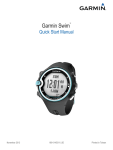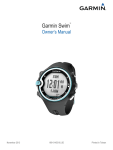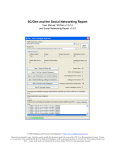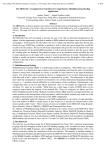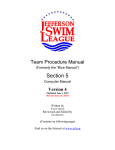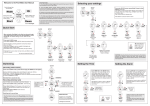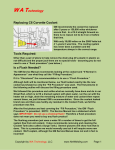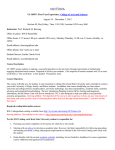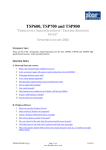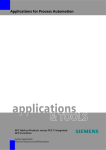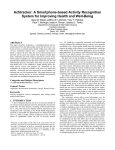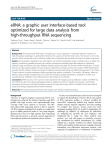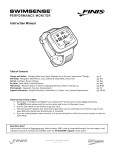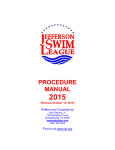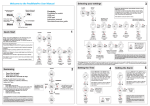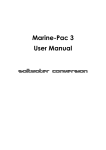Download jefferson swim league parent volunteer roster appendix a
Transcript
Jefferson Swim League Procedure Manual Appendices for Section III Revised June 1, 2008 JEFFERSON SWIM LEAGUE PARENT VOLUNTEER ROSTER APPENDIX A (Revised 2006) (Revised June 1, 2006) Day of Meet ______________________________ Location of Meet ________________________ Date of Meet _____________________________ Opponent ______________________________ Starting Time of Meet ______________________ * indicates needed for HOME MEETS ONLY POSITION NEEDED Meet Director *Referee* PARENT VOLUNTEER ________________________________ ________________________________ (Begin) (Relief) ARRIVAL TIME _____________ _____________ (Begin) (Relief) *Starter/Announcer* 1) *___________________ / ___________________* _________ / _________ ClerkofCourse 1) ___________________ / ___________________ 2) ___________________ / ___________________ _________ / _________ _________ / _________ Stroke&Turn Judges 1) ___________________ / ___________________ 2) ___________________ / ___________________ 3) *___________________ / ___________________* _________ / _________ _________ / _________ _________ / _________ Sweep Judges 1) ___________________ / ___________________ 2) ___________________ / ___________________ _________ / _________ _________ / _________ 1) *___________________ / ___________________* 1) ___________________ / ___________________ 2) ___________________ / ___________________ 3) ___________________ / ___________________ 4) ___________________ / ___________________ 5) ___________________ / ___________________ 6) ___________________ / ___________________ 7) ___________________ / ___________________ 8) ___________________ / ___________________ 9) ___________________ / ___________________ 10) ___________________ / ___________________ 11) ___________________ / ___________________ 12) ___________________ / ___________________ 13) ___________________ / ___________________ 14) ___________________ / ___________________ 15) ___________________ / ___________________ 16) ___________________ / ___________________ 17) ___________________ / ___________________ 18) ___________________ / ___________________ 19) ___________________ / ___________________ 20) ___________________ / ___________________ 21) ___________________ / ___________________ 22) ___________________ / ___________________ 23) ___________________ / ___________________ 24) ___________________ / ___________________ _________ / _________ _________ / _________ _________ / _________ _________ / _________ _________ / _________ _________ / _________ _________ / _________ _________ / _________ _________ / _________ _________ / _________ _________ / _________ _________ / _________ _________ / _________ _________ / _________ _________ / _________ _________ / _________ _________ / _________ _________ / _________ _________ / _________ _________ / _________ _________ / _________ _________ / _________ _________ / _________ _________ / _________ _________ / _________ *False Start Rope* 1) *___________________ / ___________________* _________ / _________ *Head of Table* Sorter 1) *___________________ / ___________________* 1) ___________________ / ___________________ 2) ___________________ / ___________________* 1) ___________________ / ___________________ 2) ___________________ / ___________________ 1) ___________________ / ___________________ 2) ___________________ / ___________________* 1) ___________________ / ___________________ 2) ___________________ / ___________________ 1) *___________________ / ___________________* 1) *___________________ / ___________________* 2) *___________________ / ___________________* 1) *___________________ / ___________________* _________ / _________ _________ / _________ _________ / _________ _________ / _________ _________ / _________ _________ / _________ _________ / _________ _________ / _________ _________ / _________ _________ / _________ _________ / _________ _________ / _________ _________ / _________ *Head Timer* Lane Timers (Number needed varies with number of lanes in pool; total = 3/lane) Computer Operator Computer Assistant Backup checker Awards Refreshments *Runners* *Meet Marshal* [JSL MAN sec 3 appendices.doc] © 2008 JSL Team Manual Section III Appendices Jefferson Swim League Procedure Manual Appendices for Section III Revised June 1, 2008 Jefferson Swim League 1:00 PM 05/28/2001 Page 1 APPENDIX B (Revised, 2001) FCC@BHSC 07/19/2000 Meet Program Wednesday Evening Event 1P Mixed 6 & Under 100 SC Meter Freestyle Re Lane Team Relay Seed Time Heat 1 Finals 1 2 3 4 5 FCCVA BHSCVA FCCVA FCCVA BHSCVA Event 3 Boys 910 100 SC Meter IM Lane Name Age B A A C B Team NT NT 2:01.24 NT NT Seed Time Heat 1 Finals 2 Dittmar, Will 10 3 Tungate, Robert M 9 4 Graham, Kyle C 9 FCCVA NT BHSCVA NT BHSCVA NT 1 Snyder, Jeffrey A 9 2 Thomasson, Jack 10 3 Wells, Carter L 10 4 Cooke, David F 9 5 Haar, Fred H 9 FCCVA FCCVA FCCVA FCCVA FCCVA 1 Graff, Simon 9 3 Spinosa, Michael D 10 4 Timko, Matthew O 9 5 Luck, William A 10 6 Kessler, Kyle D 10 BHSCVA 1:41.78 BHSCVA 1:32.98 FCCVA 1:36.29 BHSCVA 1:40.71 FCCVA 1:44.40 Heat 2 Finals NT NT 1:44.46 2:02.53 NT Heat 3 Finals Event 4 Girls 910 100 SC Meter IM Lane Name Age Team Seed Time Heat 1 Finals 2 Turner, Caroline R 9 3 Johnson, Jeanie A 10 4 Wright, Alice E 10 BHSCVA NT BHSCVA NT FCCVA NT 2 Graham, Scout C 10 3 Wilson, Lauren 10 4 Schwartz, Mary F 9 5 Blackwell, Brooke A 9 BHSCVA NT BHSCVA NT BHSCVA NT BHSCVA NT 1 Kennedy, Jamie 10 2 DeBUTTS, Sunny 10 3 Little, Liza S 9 4 Thomas, Brea 9 5 Nicholaou, Effie L 9 6 Brightwell, Elizabeth K 9 FCCVA NT FCCVA 1:49.20 FCCVA 1:40.63 BHSCVA 1:45.27 BHSCVA 2:03.63 FCCVA NT Heat 2 Finals Heat 3 Finals [JSL MAN sec 3 appendices.doc] © 2008 JSL Team Manual Section III Appendices Jefferson Swim League Procedure Manual Appendices for Section III Revised June 1, 2008 APPENDIX B1 (Revised, 2001) Licensed To: Jefferson Swim League 05/28/2001 Page 1 FCC@BHSC 07/19/2000 Session Report Session: 1 Wednesday Evening Day of Meet: 1 Starts at 05:00 PM Heat Interval: 45 Seconds Round Event Finals Finals Finals Finals Finals Finals Finals Finals Finals Finals Finals Finals Finals Finals Finals Finals Finals Finals Finals Finals Finals Finals Finals Finals Finals Finals Finals Finals Finals Finals Finals Finals Finals Finals Finals Entries Heats 1PMixed 6 & Under 100 Freestyle Relay 3 Boys 910 100 IM 4 Girls 910 100 IM 5 Boys 1112 100 IM 6 Girls 1112 100 IM 7 Boys 1314 100 IM 8 Girls 1314 100 IM 9 Men 1518 100 IM 10 Women 1518 100 IM 11 Boys 8 & Under 100 Medley Relay 12 Girls 8 & Under 100 Medley Relay 13 Boys 910 200 Medley Relay 14 Girls 910 200 Medley Relay 15 Boys 1112 200 Medley Relay 16 Girls 1112 200 Medley Relay 17 Boys 1314 200 Medley Relay 18 Girls 1314 200 Medley Relay 19 Men 1518 200 Medley Relay 20 Women 1518 200 Medley Relay 21P Boys 6 & Under 25 Freestyle 22P Girls 6 & Under 25 Freestyle 21 Boys 8 & Under 25 Freestyle 22 Girls 8 & Under 25 Freestyle 23 Boys 910 50 Freestyle 24 Girls 910 50 Freestyle 25 Boys 1112 50 Freestyle 26 Girls 1112 50 Freestyle 27 Boys 1314 50 Freestyle 28 Girls 1314 50 Freestyle 29 Men 1518 50 Freestyle 30 Women 1518 50 Freestyle 31 Boys 8 & Under 25 Butterfly 32 Girls 8 & Under 25 Butterfly 33 Boys 910 50 Butterfly 34 Girls 910 50 Butterfly [JSL MAN sec 3 appendices.doc] 5 13 13 6 12 6 11 7 2 4 4 3 5 2 4 2 2 3 2 20 14 19 38 22 24 5 27 7 11 13 4 8 12 9 11 Starts at 1 3 3 1 3 1 2 2 1 1 1 1 1 1 1 1 1 1 1 5 4 5 8 5 6 1 5 2 2 3 1 2 2 2 2 05:00 PM 05:03 PM 05:11 PM 05:18 PM 05:21 PM 05:28 PM 05:30 PM 05:35 PM 05:40 PM 05:42 PM 05:44 PM 05:47 PM 05:51 PM 05:55 PM 05:58 PM 06:02 PM 06:06 PM 06:10 PM 06:13 PM 06:17 PM 06:22 PM 06:27 PM 06:32 PM 06:42 PM 06:50 PM 06:58 PM 07:00 PM 07:07 PM 07:10 PM 07:13 PM 07:17 PM 07:18 PM 07:21 PM 07:24 PM 07:27 PM _______ _______ _______ _______ _______ _______ _______ _______ _______ _______ _______ _______ _______ _______ _______ _______ _______ _______ _______ _______ _______ _______ _______ _______ _______ _______ _______ _______ _______ _______ _______ _______ _______ _______ _______ © 2008 JSL Team Manual Section III Appendices Jefferson Swim League Procedure Manual Appendices for Section III Revised June 1, 2008 APPENDIX C (Revised June 1, 2006) JSL “DQ” Slip SWIMMER B Asinboy BREASTSTROKE (Events 5160) DURING Start___ Swim___ Turn___ Finish___ TEAM BHSC EVENT HEAT 4 LANE JUDGE Bob G 33 3 REFEREE FLB INDIVIDUAL MEDLEY (Events 310) ___ ILLEGAL STROKE noted in stroke section ___ILLEGAL START / FINISH (Note under Stroke) FlytoBck___ BcktoBrst___ BrsttoFree___ ___ OUT OF SEQUENCE (Fly,Bk,Brst,Fr = OK) MEDLEY RELAY (Events 1120) ___ ILLEGAL STROKE noted in stroke section ___ARMS Non Sim__ Not on Same Horz Pl__ Hands past Hips __ Elbows over water__ ___KICK Alternate___ Fly___ Scissors___ Feet not turned outward___ ___CYCLE Kick before pull___ Double pull__ Double kick___ Head not up___ ___HEAD NOT UP BY WIDEST PART OF SECOND STROKE ___BODY NOT ON BREAST ___TOUCH 1hand___ NonSim___ No___ ___OTHER ____________________________ LONG FREESTYLE (Events 6170) ___ OUT OF SEQUENCE (Bk,Brst,Fly,Fr = OK) ___HEAD DIDN’T BREAK SURFACE by 15 m ___ EARLY TAKEOFF, Swimmer # _________ ___NO TOUCH at TURN #___ SHORT FREESTYLE (Events 2130) ___ HEAD DIDN’T BREAK SURFACE by 15m ___OTHER ____________________________ FREE RELAY (Events P1 & 7180) ___ NO TOUCH at TURN ___EARLY TAKEOFF, Swimmer # _________ ___ OTHER ____________________________ ___HEAD DIDN’T BREAK SURFACE by 15 m ___NO TOUCH at TURN BUTTERFLY (Events 3140) ___OTHER ____________________________ DURING Start___ Swim___ Turn___ Finish___ FALSE STARTS, OTHER ___ HEAD DIDN’T BREAK SURFACE by 15m ___ ARMS Undrwtr recovery___ Non Sim___ X KICK Alternate___ Breast X Scissors___ ___ SHOULDERS NOT AT / PAST VERTICAL TOWARD THE BREAST ___ TOUCH 1hand___ NonSim___ No___ ___MORE THAN 1 false start ___DELAY OF MEET ___DID NOT FINISH RELAY TAKEOFF SWIMMER # ___ OTHER ____________________________ BACKSTROKE (Events 4150) DURING Start___ Swim___ Turn___ Finish___ ___ TOES OVER LIP OF GUTTER ___ HEAD DIDN’T BREAK SURFACE by 15m ___ NOT ON BACK ___ NONCONTINUOUS TURNING MOTION Extra Strokes___ Turning did not begin at end of pull___ Glided (with or without kick) prior to pull___ #2 #3 #4 LANE # 1 (O = OK X = NO) _____ _____ _____ LANE # 2 _____ _____ _____ LANE # 3 _____ _____ _____ LANE # 4 _____ _____ _____ LANE # 5 _____ _____ _____ LANE # 6 _____ _____ _____ LANE # 7 _____ _____ _____ LANE # 8 _____ _____ _____ LANE # 9 _____ _____ _____ LANE # 10 _____ _____ _____ ___ NO TOUCH at TURN ___ OTHER_____________________________ [JSL MAN sec 3 appendices.doc] POSITION: Side______ Lane_______ © 2008 JSL Team Manual Section III Appendices Jefferson Swim League Procedure Manual Appendices for Section III Revised June 1, 2008 APPENDIX D (Revised 2005) This properly completed Sweep Judge Card for Event #3, Heat #2, shows that there were NO swimmers in lanes 7 & 8 at the start of the race (“X’s” placed over lane numbers 7 & 8 at the top). The order of finish has been recorded as the swimmer in lane 3 finishing first, lane 4 finishing second, lane 1 finishing third, lane 2 finishing fourth, etc. Additional designations for difficult finishes include: Ties = connect places and lane boxes with brackets and write the word “tie” within the brackets Didn’t see finish = place a question mark “?” in lane box (do NOT guess at finish) Swimmer did not finish = write “DNF” beside lane box containing that swimmer’s lane position (Printed as White Card) [JSL MAN sec 3 appendices.doc] © 2008 JSL Team Manual Section III Appendices Jefferson Swim League Procedure Manual Appendices for Section III Revised June 1, 2008 [JSL MAN sec 3 appendices.doc] © 2008 JSL Team Manual Section III Appendices Jefferson Swim League Procedure Manual Appendices for Section III Revised June 1, 2008 APPENDIX E1 (Revised, 2004) JEFFERSON SWIM LEAGUE EXHIBITION BOYS EVENT TIMERS CARD (Printed as Light Blue Card) [JSL MAN sec 3 appendices.doc] © 2008 JSL Team Manual Section III Appendices Jefferson Swim League Procedure Manual Appendices for Section III Revised June 1, 2008 APPENDIX F (Revised, 1993) JEFFERSON SWIM LEAGUE GIRLS EVENT TIMERS CARD (Printed as Light Pink Card) [JSL MAN sec 3 appendices.doc] © 2008 JSL Team Manual Section III Appendices Jefferson Swim League Procedure Manual Appendices for Section III Revised June 1, 2008 APPENDIX F1 (Revised, 2004) JEFFERSON SWIM LEAGUE EXHIBITION GIRLS EVENT TIMERS CARD (Printed as a Light Pink Card) [JSL MAN sec 3 appendices.doc] © 2008 JSL Team Manual Section III Appendices Jefferson Swim League Procedure Manual Appendices for Section III Revised June 1, 2008 APPENDIX G (Revised, 2007) RECOMMENDED TIMING PROCEDURES FOR JEFFERSON SWIM LEAGUE In dual meets there MUST be three timers in each lane PLUS the designated head timer(s). Beginning with the 2005 season, the official times are the primary determination of place (finish position) with sweep judges as secondary. In dual meets where less than half of the lanes are covered by three timers, the sweep judges will be considered the primary method of determining place. It must be noted that this situation will slow down the work at the table. If enough timers are not available, a MINIMUM of two per lane is required (otherwise the event cannot be swum) with any extras assigned to the center lanes. More experienced timers should be assigned to the center lanes and also paired with beginners when possible. The Head Timer organizes timers prior to the meet, gives out watches, gives instructions, answers questions, assigns lanes, and serves as a backup timer. Beginning in 2007, a new method of timing and recording was developed using TWO watches (one blue and one green) per timer. The timer starts one watch (e.g. blue) for heat #1 and that watch is stopped, but not cleared, at the end of the heat. The following heat #2 is then started on the other cleared watch (e.g. green). Once that heat #2 is in the water, the times from the previous heat #1 are recorded from the blue watch and that watch is cleared. When the following heat #2 is complete, the green watch is stopped, but not cleared. The next heat #3 is started on the cleared blue watch. Once that heat #3 is in the water, times from heat #2 are recorded from the green watch and that watch is cleared. This process continually repeats itself throughout the meet with the timers not recording times from heats until the following heat is started with another watch. Timers must keep one cleared watch available at all times so as not to delay the start of any heat. I. One timer in each lane should have a small clipboard and a pencil. This timer takes the timing card from the swimmer and verifies name, event, heat and lane and initials the card in the upper righthand corner to confirm this information. In addition, this timer will record all times given by each timer at the end of the race and initial the “Initials” box verifying the accuracy of those times. 2. All timers should clear their watches after the time has been recorded and pay attention to the Starter. If you are not prepared to time or can not see the CTS start system when the Starter asks, “Timers and Judges ready?” you should raise your hand and attract the starter. 3. All timers should concentrate on the strobe light of the CTS starting system and not rely on the sound. 4. Start your watch from the flash of the strobe light (or flash of the gun, if used). As stated above, you should not rely on the sound as a partial second will be lost. If you miss the start or your watch is not running properly, you should call for the head timer to take your place. It is not possible to guess time missed at the start. 5. Stop your watch at the end of the race when any part of your swimmer’s body touches the end wall OR passes over the edge of the pool or gutter. Keep in mind that many races are multilap events – do not stop your watch until the completion of the last lap. 6. Remember that times are not given to the time recorder until AFTER THE BEGINNING OF THE NEXT HEAT. Do NOT clear your watch until all of the times are recorded. Obviously common sense must prevail if a swimmer has finished well before the end of the heat, times may be recorded prior to the start of the next heat. 7. Times should be given to the timer holding the swimmer’s card by calling out readings completely (e.g. “2 minutes, 8 seconds, and 34 hundredths. Do not clear your watch until all times are recorded. You may tell a swimmer his/her time, but be certain to say that it is unofficial. 8. The timer holding the swimmer’s card must initial the card and give it to the runner. [JSL MAN sec 3 appendices.doc] © 2008 JSL Team Manual Section III Appendices Jefferson Swim League Procedure Manual Appendices for Section III Revised June 1, 2008 APPENDIX H (Added, 2005) JSL Guidelines for Special Needs Swimmers The Jefferson Swim League has a long history of accommodating swimmers with special needs. In fairness to these swimmers and the other swimmers who participate, the following guidelines were adopted by the JSL Board at its April 3, 2005 meeting: Under Article VI of the JSL Bylaws: 13. The Meet Director has the authority to modify the rules for the swimmer with a disability using the guidelines under Article 105 of USA Swimming Rules and Regulations. Additional modifications may not be made unless the swimmer swims as exhibition. (Revised, 2005) The Board confirmed that the following additional modifications beyond those allowed by Article 105 of the USA Swimming Rules and Regulations will result in the swimmer being classified as exhibition: Ø Ø Ø Ø Obtaining physical assistance (e.g., kickboard, flotation device, etc) Obtaining personal assistance (e.g., another swimmer assisting the swimmer in the water during the race) Swimming down in a lower age group (e.g., a 9year old swimming as a mite) Swimming a shorter distance (e.g., swimming 25m in a 50m race) Additionally the Executive Committee (via email to the President) must be notified of the child and the special needs of that child. That information will be communicated to the full Board. Swimmers who have been granted additional modifications beyond those allowed by Article 105 of the USA Swimming Rules and Regulations are eligible for time improvement or super swimmer ribbons, but not place ribbons or points. The coach is responsible for ensuring that the swimmer is entered as exhibition and that an exhibition timing card is used. These swimmers are also eligible to swim in the Championship provided they have swum in at least two League meets. It is important to note that special needs swimmers who are only granted accommodations as described under Article 105 of the USA Swimming Rules and Regulations are fully eligible for all awards and points and are, of course, eligible to swim the Championship provided they have swum in at least two League meets. Coaches are responsible for notifying the appropriate officials (Referee, Meet Directors, Starter, Head Stroke& Turn Judge, etc) of the name, team, and accommodation of any special needs swimmers prior to the start of the meet. This will prevent unnecessary embarrassment to the swimmer or officials due to inappropriate disqualifications. [JSL MAN sec 3 appendices.doc] © 2008 JSL Team Manual Section III Appendices Jefferson Swim League Procedure Manual Appendices for Section III Revised June 1, 2008 APPENDIX H1 (Added, 2007) Procedure for Entering Special Needs Swimmers The swimmer must be registered with his/her correct birth date with the JSL. The President of the JSL must be notified via email of the swimmer’s name, team, and special accommodation prior to the first meet of the season. The team entering the special needs swimmer(s) must notify the team hosting the meet so that the swimmer(s) can be appropriately placed in the proper event. The swimmer(s) must be entered by his/her team in an event in the meet so that the swimmer(s) will be on the Meet Entries file submitted to the JSL by the appropriate meet entry deadline. The entering team must inform the host team which event the swimmer(s) should be entered into and remind the host team to seed the swimmer(s) into an outside lane if desirable. This can be done in a word for windows document that can be submitted at the time of meet entries. The person who is responsible for the premeet work in Meet Manager must do the following: 1. Locate the swimmer(s) in the Meet Manager database. 2. At the top of the screen a section called “entries” can be seen. 3. Select “All entries”. This selection will allow the swimmer(s) to be entered in any event regardless of event age. 4. Make sure that the swimmer is removed from the event in which he/she was originally entered. 5. When entering the swimmer in the desired event, make sure that the swimmer is entered as an exhibition swimmer if any accommodations are made which exceed those in Article 105 of the USA Swimming Rules. 6. Exhibition swimmers are always seeded last (in the slowest heat), but the event will have to be adjusted to ensure that the swimmer is seeded into an outside lane if so desired by the entering team. 7. If the swimmer is entered in any event other than the short free, that swimmer counts toward the team’s total entry for that event. If the swimmer is swimming out of age group or receives any accommodations which exceed those in Article 105 of the USA Swimming Rules, he/she must be entered as exhibition. It is the coach’s responsibility to notify the referee and all appropriate officials of swimmers who are receiving any special accommodations before the start of the meet. Please direct any questions to Jessica Simons at [email protected] or 2951582 [JSL MAN sec 3 appendices.doc] © 2008 JSL Team Manual Section III Appendices Jefferson Swim League Procedure Manual Appendices for Section III Revised June 1, 2008 APPENDIX J (Revised, 2005) IMPORTANT NOTE: Beginning with the 2005 season this form should only be used when there are three timers in less than half of the lanes. If there are three timers in half or more of the lanes, the times will be the primary determination of place (order of finish), not the sweep judges, and balloting is not necessary. (Printed as Lt. Blue 8 1/2” x 11”) [JSL MAN sec 3 appendices.doc] © 2008 JSL Team Manual Section III Appendices Jefferson Swim League Procedure Manual Appendices for Section III Revised June 1, 2008 APPENDIX K (Revised, 2004) Individual Event Label Examples st th (one for each swimmer 1 – 16 ) Place: 1 st Time: 1:29.96 #3 Boys 910 100 SC Meter IM Spinosa, Michael D 10 Boar’s Head Swim Team – 07/19/2000 FCC@BHSC Place: 2 nd Time: 1:35.62 #3 Boys 910 100 SC Meter IM Timko, Matthew O 9 Farmington Country Club – 07/19/2000 FCC@BHSC Place: 3 rd Time: 1:37.71 #3 Boys 910 100 SC Meter IM Luck, William A 10 Boar’s Head Swim Team – 07/19/2000 FCC@BHSC Relay Event Label Examples (1 label for each swimmer, 4 / team) Place: 1 st Time: 1:53.13 #1P Mixed 6 & Under 100 SC Meter Frees Von Quillfeldt, Anniken H 6 Farmington Country Club – C 07/19/200 FCC@BHSC Place: 1 st Time: 1:53.13 #1P Mixed 6 & Under 100 SC Meter Frees White, James J 6 Farmington Country Club – C 07/19/200 FCC@BHSC Place: 1 st Time: 1:53.13 #1P Mixed 6 & Under 100 SC Meter Frees Satterfield, Calvin 6 Farmington Country Club – C 07/19/200 FCC@BHSC Place: 1 st Time: 1:53.13 #1P Mixed 6 & Under 100 SC Meter Frees Lesemann, Katie 5 Farmington Country Club – C 07/19/200 FCC@BHSC [JSL MAN sec 3 appendices.doc] © 2008 JSL Team Manual Section III Appendices Jefferson Swim League Procedure Manual Appendices for Section III Revised June 1, 2008 APPENDIX L (Added, 2008) NOAA RADIO INFORMATION AND GUIDELINES (adopted by the JSL Board at its June 1, 2008 meeting) JSL provides all teams with a First Alert WX150 Radio for use during swim meets. This radio displays National Oceanic and Atmospheric Administration (NOAA) civil and emergency alert text messages on its LCD screen. When an alert is received, a siren sounds and the radio automatically switches to voice broadcast. Messages are identified by one of three colorcoded LED lights as follows: “Advisory” (yellow), “Watch” (orange), or “Warning” (red). Meet Directors are expected to be familiar with its operation and have the radio on and fully operational during arrival, warmups, swim meet, and the period immediately following the meet. A complete User’s Manual has been distributed along with the radios and is also attached as Appendix M. As with other equipment, the radios remain the property of JSL and repair or replacement is the responsibility of the individual team. The NOAA Radio will be properly programmed and must be tuned to Weather Band Channel 3 (162.450 MHz) to receive NOAA broadcasts for most of the areas where there will be JSL Swim meets. For teams outside of Albemarle County, a different channel may have to be selected if the NOAA Radio is not properly receiving the broadcast. There are also Specific Area Message Encoding (S.A.M.E. or FIPS) codes which enable the radio to receive messages relevant to the specific area for all JSL home meet locations. JSL will preset each team’s radio based on the expected needs and location of home meets, however teams may choose to add more “SAME” or “FIPS” codes to cover more of their surrounding areas. A complete list of all Radios and preprogrammed codes is on the following page. Meet Directors weatherrelated decisions are still governed by JSL Bylaws under Article VI, #17 and #18. The radio is used to supplement, but not replace, the normal common sense clues that there is a weather condition approaching which may be potentially dangerous for swim meet participants. Additionally the radio may be helpful in deciding whether to cancel a meet or wait for a storm to pass over. As always, these decisions should be made with the safety of the swimmers and participants as the main determining factor. 1. The Host Team’s NOAA Radio must have working batteries installed (battery warning light off) and plugged into a working power outlet at poolside (specifically the scoring table) where a number of officials would be able to monitor & hear any alert sirens. The radio should always be accessible to the Visiting Team Meet Director and Coach. 2. The Host Team’s NOAA Radio must be turned on, have the antenna extended, and be fully operational during arrival, warmups, swim meet, and the period immediately following the meet until the participants have generally left the area. 3. The Host Team Meet Director must push the “Listen” button to confirm that a signal is being received and adjust the antenna for maximum signal. (The “listen” button may be pushed again to cut the voice broadcast off during the meet.) 4. Immediately after the sound of any alert siren, the Meet Directors must be notified and listen to any voice alerts. 5. Depending on the nature of an alert or current weather observations, “The Host Team Meet Director shall be responsible for making and implementing all decisions regarding weather issues” (Article VI, #17). These decisions include, but are not necessarily limited to: a. when to stop the meet in the event of thunder or lightning b. how long to stop the meet after the observation of thunder or lightning or rain hard enough to obscure the bottom of the pool (minimum 15 minutes after thunder or lightning) c. where to direct participants when the pool area needs to be cleared d. when to resume the meet after a weather delay Note that host pools may have stricter policies which must be followed regarding the above. 6. In the event that a meet may not be able to continue, “The Home Meet Director in conference with the Visiting Team Meet Director(s) will decide when a meet shall be suspended due to inclement weather or other circumstances (Article VI, #18). 7. It is expected that the Meet Directors will jointly reach the best decision for the safety of the meet participants based on all available information, not just the NOAA Radio. 8. It is recommended that visiting teams always take their NOAA Radios to away meets to serve as a backup. 9. Although the NOAA Radios have been specifically issued for use at JSL swim meets, the JSL Board does not discourage further use of the radios on the team’s premises for other functions such as daily practices, etc. [JSL MAN sec 3 appendices.doc] © 2008 JSL Team Manual Section III Appendices Jefferson Swim League Procedure Manual Appendices for Section III Revised June 1, 2008 APPENDIX N (Revised June 1, 2008) 2008 JSL Gold Time Standards Event # Boys Gold Times 25 Y 25 M Age/Distance/Stroke 50 M Girls Gold Times 50 M 25 M Event # 25 Y 3 1:36.84 1:47.49 910 100 IM 1:42.60 1:32.44 4 5 1:24.01 1:33.25 1112 100 IM 1:30.07 1:21.14 6 7 1:11.31 1:19.15 1314 100 IM 1:23.75 1:15.45 8 9 1:04.88 1:12.02 1518 100 IM 1:22.41 1:14.24 10 210 24.85 27.58 27.58 6 & Under 25 Free 27.97 27.97 25.20 220 21 17.92 19.89 19.89 8 & Under 25 Free 20.95 20.95 18.87 22 23 35.38 39.28 40.08 910 50 Free 40.43 39.63 35.70 24 25 31.81 35.31 36.11 1112 50 Free 36.15 35.35 31.85 26 27 27.36 30.37 31.17 1314 50 Free 33.69 32.89 29.63 28 29 24.94 27.68 28.48 1518 50 Free 32.33 31.53 28.40 30 31 21.88 24.29 24.29 8 & Under 25 Fly 25.15 25.15 22.65 32 33 46.46 51.57 52.27 910 50 Fly 47.30 46.60 41.98 34 35 38.66 42.91 43.61 1112 50 Fly 41.06 40.36 36.36 36 37 31.97 35.49 36.19 1314 50 Fly 37.91 37.21 33.52 38 39 28.16 31.25 31.95 1518 50 Fly 36.25 35.55 32.02 40 410 30.78 34.16 34.16 6 & Under 25 Back 31.59 31.59 28.46 420 41 23.28 25.84 25.84 8 & Under 25 Back 25.85 25.85 23.29 42 43 42.88 47.60 48.20 910 50 Back 48.05 47.45 42.75 44 45 39.60 43.95 44.55 1112 50 Back 42.67 42.07 37.90 46 47 35.30 39.18 39.78 1314 50 Back 40.11 39.51 35.59 48 49 30.59 33.95 34.55 1518 50 Back 38.95 38.35 34.55 50 51 25.05 27.81 27.81 8 & Under 25 Breast 28.61 28.61 25.78 52 53 48.14 53.44 54.44 910 50 Breast 52.94 51.94 46.79 54 55 43.40 48.17 49.17 1112 50 Breast 46.61 45.61 41.09 56 57 36.69 40.73 41.73 1314 50 Breast 44.64 43.64 39.32 58 59 33.50 37.19 38.19 1518 50 Breast 43.24 42.24 38.06 60 61 41.28 45.82 46.62 8 & Under 50 Free 49.25 48.45 43.65 62 63 1:24.43 1:33.71 1:35.31 910 100 Free 1:31.63 1:30.03 1:21.11 64 65 1:12.63 1:20.62 1:22.22 1112 100 Free 1:19.88 1:18.28 1:10.52 66 67 1:02.23 1:09.08 1:10.68 1314 100 Free 1:15.02 1:13.42 1:06.14 68 69 55.37 1:01.46 1:03.06 1518 100 Free 1:10.57 1:08.97 1:02.13 70 Prepared by Chip Grobmyer [JSL MAN sec 3 appendices.doc] © 2008 JSL Team Manual Section III Appendices Jefferson Swim League Procedure Manual Appendices for Section III Revised June 1, 2008 JSL Sportsmanship Rating Form APPENDIX O (Revised June 4, 2003) (Revised, 2004) Good sportsmanship has always been a core value of the JSL. As part of an ongoing effort to recognize and reward good sportsmanship within the Jefferson Swim League, both visiting and host Meet Directors are required to independently fill out the following form at the conclusion of each swim meet. This should reflect a fair, honest, and objective appraisal of the opposing team’s conduct prior to, during, and following the swim meet. You also will rate your own team in the last section, although those scores will NOT count towards the endofseason JSL Sportsmanship Awards. You will be notified via email and given a password to access this form on www.jsl.org. ONLY If you are unable to access the internet, please complete, fold correctly, tape closed, and mail to the current webmaster within 24 hours using this form. Print clearly, circle appropriate scores, and don’t forget to apply the required first class postage. This form completed by _______________________ Team ________ Meet Date ________ Host Team _____ Visiting Team(s) #1 ____ #2____ Rating for opposing Team ______ Disagree The opposing team treated our team fairly and respectfully. The opposing team helped make this meet a rewarding experience for our swimmers. The opposing team was gracious in winning/losing. The opposing team adhered to JSL rules and regulations without stretching boundaries. The opposing team provided a healthy and challenging experience for our swimmers. Our team really enjoyed swimming against this opposing team. Neutral Agree 1 2 3 4 5 1 2 3 4 5 1 2 3 4 5 1 2 3 4 5 1 2 3 4 5 1 2 3 4 5 If this were a Trimeet, rate the other opposing team Rating for opposing Team ______ Disagree Neutral Agree The opposing team treated our team fairly and respectfully. The opposing team helped make this meet a rewarding experience for our swimmers. The opposing team was gracious in winning/losing. The opposing team adhered to JSL rules and regulations without stretching boundaries. The opposing team provided a healthy and challenging experience for our swimmers. Our team really enjoyed swimming against this opposing team. 1 2 3 4 5 1 2 3 4 5 1 2 3 4 5 1 2 3 4 5 1 2 3 4 5 1 2 3 4 5 Rate your own team (score does not count) Rating for your own Team ______ Disagree Neutral Our team treated the opposing team(s) fairly and respectfully. Our team helped make this meet a rewarding experience for the opposing team’s swimmers. Our team was gracious in winning/losing. Agree 1 2 3 4 5 1 2 3 4 5 1 2 3 4 5 Our team adhered to JSL rules and regulations 1 without stretching boundaries. Our team provided a healthy and challenging 1 experience for the opposing team’s swimmers. The opposing team(s) really enjoyed swimming 1 against our team 2 3 4 5 2 3 4 5 2 3 4 5 [JSL MAN sec 3 appendices.doc] © 2008 JSL Team Manual Section III Appendices Jefferson Swim League Procedure Manual Appendices for Section III Revised June 1, 2008 Tidbits for the Referee (Contributed by Kevin Hogan) Appendix P (Added June 1, 2006) 1. Know the rules, know the interpretations, know them cold. If you are unsure of what something means, find out before you need to know. 2. Coaches aren’t stupid. But coaches don’t always know the rules either. See #1 above. Knowledge is power. 3. Referees aren’t god (god on deck). Power is tempered with responsibility. 4. Questions of S&T Judges should be in the context of the “three questions.” What was your jurisdiction? What did you see? What rule was violated? 5. Use rulespecific descriptions and not “shorthand” to describe a violation. It is illegal to finish the backstroke leg of the IM on stomach; it is not illegal to perform a flip turn at the backtobreast transition. Saying that someone was disqualified for performing a flip turn under such circumstances is wrong, they should be disqualified for not finishing the backstroke leg on their back. 6. Almost illegal IS legal. Let it go. Pushing the limits of the rules is okay as long as the action is within the rules. 7. Coaches are paid to be advocates for their athletes. Expect and allow coaches to be passionate advocates. Passion should not, however, translate into tirades, abuse, or other disrespectful behavior. 8. Listen, repeat, explain. Listen and focus on what the coach is saying. Repeat back the gist of what was said. Explain your ruling in the context of the rules. Do NOT be dismissive. 9. Treat every discussion with a coach as a unique encounter. Some argue less, some argue more, but each problem should be handled in the context of its own merits. 10. If you make a mistake, admit it, fix the problem, and move on. Wrong and stubborn doesn’t make you a better Referee. If you learn from your mistakes you’ll grow as an official. 11. Be proactive, not reactive. A problem prevented is an issue that doesn’t have to be fixed later. 12. If it isn’t prohibited by the rules it is legal. Unless the rules specifically prohibit something that is new, novel, different, unexpected, etc., it is legal. See also #5 above. [JSL MAN sec 3 appendices.doc] © 2008 JSL Team Manual Section III Appendices Jefferson Swim League Procedure Manual Appendices for Section III Revised June 1, 2008 Strokeand Turn Judge Guidelines APPENDIX Q (Contributed by Kevin Hogan) Philosophy of Officiating · The rules “are designed to provide fair and equitable conditions of competition and promote uniformity in the sport so that no swimmer shall obtain unfair advantage over another.” o Judging should be consistent among different officials at a meet o Judging should be consistent at different meets o All of the rules are enforced, we don’t individually choose to enforce some rules and ignore others o The rules are enforced across all age groups and levels of ability o Officials should be neutral in their enforcement of the rules; don’t favor your team over teams, don’t favor your child over other children · The benefit of the doubt always goes to the swimmer o Rule infractions don’t result in a loss of yardage, foul shots, time in a penalty box, time penalties, etc.; they result in disqualification · Call what you see, not what you don’t see · Ugly ain’t (necessarily) illegal · If it isn’t specifically prohibited by the rules, it is legal · Know the rules; review the rules before meets Dress · White shirt/blouse · Blue shorts/pants/skirt · White socks and shoes, or sandals Placement, Jurisdiction and Rotation · Will be determined by the Referee or Head Stroke & Turn official at meet · Stroke judge has flagtoflag jurisdiction o 1 on each side of pool, each covering the lanes on that side of the pool [JSL MAN sec 3 appendices.doc] (Added June 1, 2006) o Walk flagtoflag, generally lagging behind the slowest swimmer · Turn judge has walltoflag jurisdiction o Cover 24 lanes as assigned § Stand at the middle of the lanes being covered · Rotation is determined by the Referee or Head stroke & turn official, but generally occurs after each girls event and in a clockwise direction · Equal time should be spent observing each of the swimmers within your jurisdiction o If one or more lanes are empty, an equal amount of time should be spent on the empty lane(s) o Observe similar aspects of the swim · When working, your full attention should be on the swimmers when they are within your jurisdiction · Don’t wonder off when you’re suppose to be working Disqualifications · Most disqualifications will be for violations of the technical rules governing the basic strokes, although additional DQs include the following: o Not starting and finishing in the same lane (otherwise any portion of the swim may be completed in a different lane) o Obstructing another swimmer by swimming across or interfering with them o Grasping the lane dividers to assist forward motion o Standing on the bottom is prohibited in any race except freestyle, and the swimmer may not walk or spring from the bottom © 2008 JSL Team Manual Section III Appendices Jefferson Swim League Procedure Manual Appendices for Section III Revised June 1, 2008 Strokeand Turn Judge Guidelines · o Coaches should dispute a call, not parents Raise hand overhead on observing a violation of the rules that occurs within your jurisdiction o When it does not interfere with your ability to judge swimmers within your jurisdiction, you may explain the rule and your call to anyone who is being reasonable o If you’re hesitant in raising your hand, the call was probably too close to make, the benefit of the doubt goes to the swimmer, therefore no call o Anything other than a simple inquiry should be directed to the Referee or the Host Meet Director (meet without a Referee) who have the authority to uphold or overturn disqualifications o If you raise your hand and then decide that it was not an infraction, you do not have to make the call o Serves to notify the Referee and coaches that a call has been made · · · o Don’t be afraid to withdraw a disqualification if you made a mistake, but don’t feel the need to back down from a call that you believe was made correctly Relay Takeoff Judging · Dual confirmation is used in which two officials, preferably from different vantage points, observe the relays for early takeoffs · When the toes of the outgoing swimmer leave the blocks, look down to determine if the incoming swimmer has touched the wall · If you observe an early takeoff, mark the corresponding swimmer and lane number · At the end of the race, compare your observations with the observations of the other official covering the same lanes · If both officials agree that the same swimmer took off early, it is a disqualification, if only one official observed an early take off, it is not a disqualification · When dual confirmation is being used to judge takeoffs, the hand is not raised on observing an early takeoff Confirm the name of the swimmer with the seed card o We will not talk to the swimmers this year · At meets without a Referee the DQ slips should be left with the timer or a runner · At meets with a Referee all potential disqualifications must be reported to the Referee who will either accept or deny the disqualification o Be prepared to report: (1) your jurisdiction; (2) what you saw; and (3) what rule was violated o If your call is questioned by the Referee, please remember that it is not personal; the Referee is doing his/her job o If your call is overturned, take it as a learning experience · o Listen, you might learn something After signaling a DQ, continue to observe all swimmers until they are no longer within your jurisdiction as additional violations by the same or a different swimmer may be observed Fill out DQ slip and note swimmers name, event #, heat #, lane #, infraction, and your name Disagreements over calls [JSL MAN sec 3 appendices.doc] APPENDIX Q (continued) © 2008 JSL Team Manual Section III Appendices Jefferson Swim League Procedure Manual Appendices for Section III Revised June 1, 2008 Good Starting Procedure (Contributed by Kevin Hogan) · · · · · · · · · · · · Work with the Referee and Clerk of Course to ensure a steady flow of swimmers Speak in a conversational tone (“take your mark” should be said with the same emphasis as “shut the door”) Invite the swimmers to swim, do not command them For the forward start, the feet can be anywhere on the block prior to “take your mark”, but at least one foot must be at the front of the block after the “take your mark” command has been given The forward start may be from the block, the deck, or in the water (for the latter start at least one hand must be in contact with the wall or starting platform For the backstroke start, the hands must be placed on the gutter or on the starting grips For the backstroke start the toes must not be over the lip of the gutter before or after the start Before the start, the starter is responsible for toes not being over the lip of the gutter, after the start the turn judge is responsible for toes over the gutter When the swimmers are stationary, give the starting signal (note: “stationary” not “motionless”) Do not attempt to “catch” swimmers on their starts A swimmer accidentally falling off the blocks prior to the “take your mark” command should not be penalized with a false start If one or more swimmers are slow to take their mark, or are otherwise unstable, say “stand” (forward starts) or “relax” (backstroke starts) and allow the swimmers to regroup. o If the heat is stood up again for the same problem, issue a generic warning, for example “please respond promptly to my command and remain motionless for the start” o If the heat is stood up a third time for the same problem, warn the individual swimmer if it is the same person, for example “lane 3, please…. o Additional problems with the same swimmer may result in a delay of meet disqualification [JSL MAN sec 3 appendices.doc] · · · · · · · Appendix R (Added June 1, 2006) If a swimmer leaves their mark early and the starting signal is subsequently given, the heat must be recalled by activating the recall horn (note that the Referee may also initiate a recall by blowing his/her whistle) If a heat is recalled for a false start: o Determine if there is a dual confirmation; if not, no false start has occurred o If it is a swimmer’s second false start, the swimmer is disqualified and they may not swim o Step the swimmers back up/in and if there was a false start announce “false start, lane #”, and restart as usual If a swimmer leaves their mark prior to the sounding of the starting signal o Stand the heat o Determine if there is dual confirmation that a false start has occurred (slipping off the block, for example, is not a false start) o If it is a swimmer’s second false start, the swimmer is disqualified and they may not swim o step the offending swimmer back up/in if it is their first false start (or not a false start), announce “false start, lane #”, and restart as usual If a swimmer leaves their mark early in reaction to the movement of another swimmer, or in reaction to the “stand” or “relax” command, that swimmer may be relieved of a false start False starts are called on the individual swimmer, not on the field If a swimmer is charged with two false starts in the same heat, the swimmer is disqualified and may not swim in the race A swimmer who deliberately enters the water early (for example, before the “take your mark” command is completed) may be disqualified for delay of meet (this is NOT a false start and only has to occur once for a DQ) © 2008 JSL Team Manual Section III Appendices Jefferson Swim League Procedure Manual Appendices for Section III Revised June 1, 2008 Whistle Starts (Contributed by Kevin Hogan) Appendix S (Revised June 1, 2008) General The Referee should stand next to the Starter, with the Starter given first preference as to where he/she is positioned. The Referee controls the flow of the meet and is responsible for getting the swimmers onto the blocks. The Starter is responsible for ensuring that all swimmers get a fair start. Verbiage With the exception of making needed meet announcements (for example, events to report to Clerk of Course), the Starter should try to limit any verbiage to that given below. Routine use of “step up” for example generally results in swimmers ignoring the whistle commands. The announcement of event #, gender, distance, and stroke should immediately follow the 45 whistle chirps. Use the singular for distance (yard, not yards; meter, not meters). Use the complete event name, not an abbreviation (Individual Medley, not IM; Freestyle, not Free; Breaststroke, not Breast; Backstroke, not Back; Butterfly, not Fly or Butter). Closing the Heat When all the swimmers in a heat have stepped onto the blocks/into the water, the Referee fully extends his/her arm (the one closest to the Starter) towards the Starter which then gives control of the heat to the Starter. It is then the Starter’s responsibility to ensure a fair start for all the swimmers. Once the Referee’s arm has been fully extended towards the Starter the heat is said to be closed. Swimmers stepping onto the blocks/into the pool after this point can be disqualified for a delay of meet. For this reason it is extremely important that the Referee not rush this procedure if all the expected swimmers are not immediately on the blocks/in the water. Waiting a reasonable amount of time is all it usually takes for the missing swimmer to show up. In practice, unless a swimmer arrives after the Starter has begun saying “take your mark”, it is best to keep moving. Also, we don’t penalize swimmers for mistakes made by officials. If a swimmer is told the wrong heat number by a timer, blocked in their ability to get to the block (three large adult timers, exiting swimmers, runners, etc. can all be intimidating roadblocks for a six year old) etc., the swimmer should be allowed to swim, even if it means swimming them in a different or extra heat. Common sense should prevail, particularly as we implement this new starting procedure. Everyone would prefer that the swimmers swim rather than miss their heat. The bottom line is that unless a swimmer is willfully ignoring the starting signals or is otherwise involved in extracurricular activities behind the blocks, it is best to let them swim. If a delay of meet disqualification is made (or not made), however, it is important that any similar circumstances be treated the same way throughout the meet. False Starts False starts should be recalled, and the recall can be initiated by either the Referee or Starter. Dual confirmation by both the Referee and Starter is required to charge a swimmer with a false start. The Referee and Starter should independently mark their heat sheets as to the lane(s) false starting and a false start should be called only if there is agreement between the two officials. No discussion should take place, there is either agreement or there isn’t. A swimmer must false start twice to be disqualified for a false start. False starts are charged to the individual swimmer and not to the field, thus more than one recall could occur without a swimmer being disqualified for a false start. Delay of Meet vs. False Start A swimmer who delays the start by entering the water “just for the fun of it” (for example, purposely dives in before the Starter finishes saying “Take your mark”) can be disqualified for “delay of meet.” This is not the same as a false start and does not require two instances for it to be a disqualification. The Referee must be certain that this was a case of “hot dogging” and not a legitimate false start. [JSL MAN sec 3 appendices.doc] © 2008 JSL Team Manual Section III Appendices Jefferson Swim League Procedure Manual Appendices for Section III Revised June 1, 2008 Whistle Start Protocol Appendix T (Contributed by Kevin Hogan) (Revised June 1, 2008) For the first heat of an event: 45 whistle chirps (modulate volume as needed and appropriate). The whistle blasts signify that it is time for the next heat to get ready to step onto the blocks or into the water. These should generally occur about the time the slowest Referee: swimmer in the water is crossing under the backstroke flags at the start end of the pool. If the last heat of an event is swimming the blasts can come a little earlier so that the Starter has more time to announce the event number, gender, distance, stroke and heat number. Starter: “Event (number), (gender), (distance), (stroke). Heat 1.” 1 long whistle (modulate volume as needed but must be loud enough to be heard). This is the signal for the swimmers to step onto the blocks or into the water. This whistle should occur when the slowest swimmer in the water finishes. Additional long whistle if backstroke or medley relay. This is the signal for the swimmers to return to the wall and to position their feet. You Referee: shouldn’t wait until all the swimmers are at the wall; it doesn’t mean place your feet, it means get to the wall and get ready to swim. When all the swimmers are on the blocks/at the wall, fully extend your arm towards the Starter. This signals that the heat is closed and the swimmers are now under the control of the Starter. Starter: “Take your mark.” When all the swimmers become stationary, sound the starting signal “BEEP”. Swimmers swim… For subsequent heats of the same event number (note that italicized comments above apply to the corresponding signals below): Referee: 45 whistle chirps. “Heat (number).” Starter: Starting with heat 2, only the heat # is announced. Do not announce gender, distance, or stroke. 1 long whistle. Referee: Additional long whistle if backstroke or medley relay. When all the swimmers are on the blocks/at the wall, fully extend your arm towards the Starter. Starter: “Take your mark.” Starting signal. Swimmers swim…. Continue in this pattern until all heats of this event have been swum. After all heats of a given event have been swum, recycle back to the instructions for the first heat of the next event. [JSL MAN sec 3 appendices.doc] © 2008 JSL Team Manual Section III Appendices Jefferson Swim League Procedure Manual Appendices for Section III Revised June 1, 2008 USA Swimming Rules & Regulations Changes and Interpretations for 2008 Appendix U (Revised June 1, 2008) (Contributed by Kevin Hogan) The 2008 USAS Rules & Regulations went into effect 15 May 2008. Those with a sharp eye or good memory will notice that the portions of the breaststroke and backstroke rules have been reworded. The intent of the wording differences is that they are clarifications meant to make the rule easier to understand. The wording differences are not meant as material changes to the rules. Practically speaking this means that we have the same rule before and after the rewording and there is no change in the interpretations or enforcement of the rules. This intent is reinforced on the inside cover of the 2008 rule book where these rewordings are not mentioned under the heading “Major Legislation and Rule Changes for 2008.” Also, any discussion at the national level of the rewording is always framed in the context that these “are not changes” and any reference to the rewording as a rule change is corrected as being a rewording. No new rules interpretations were issued by the Rules and Regulations Committee. [JSL MAN sec 3 appendices.doc] © 2008 JSL Team Manual Section III Appendices
























